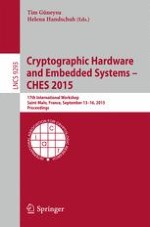This book constitutes the refereed proceedings of the 17th International Workshop on Cryptographic Hardware and Embedded Systems, CHES 2015, held in Saint Malo, France, in September 2015. The 34 full papers included in this volume were carefully reviewed and selected from 128 submissions. They are organized in the following topical sections: processing techniques in side-channel analysis; cryptographic hardware implementations; homomorphic encryption in hardware; side-channel attacks on public key cryptography; cipher design and cryptanalysis; true random number generators and entropy estimations; side-channel analysis and fault injection attacks; higher-order side-channel attacks; physically unclonable functions and hardware trojans; side-channel attacks in practice; and lattice-based implementations.
